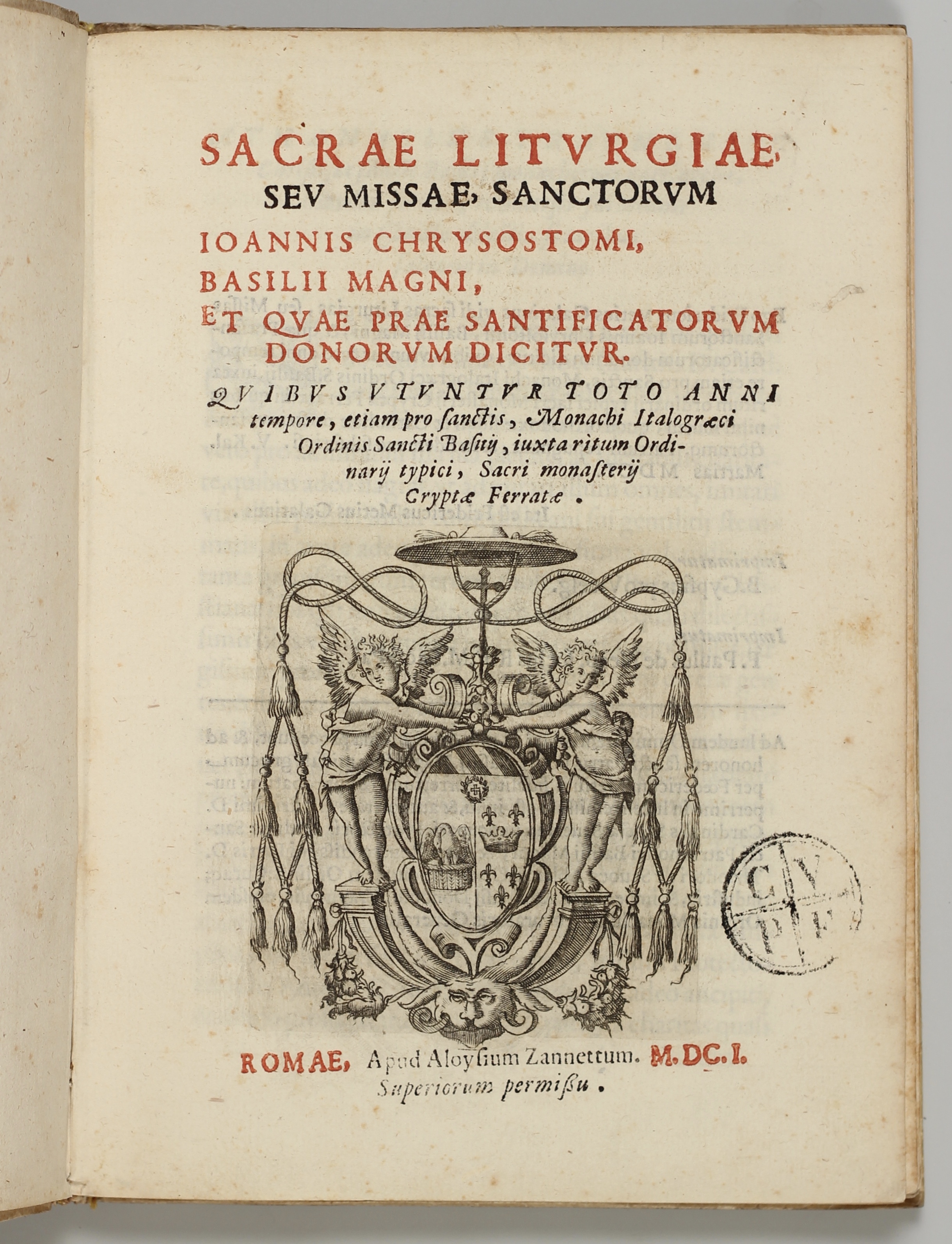Liturgy - Chrysostomus, Johannes, Basilius Magnus
Sacrae liturgiae … — Rome 1601
8.500 €Sacrae liturgiae, seu missae, sanctorum Ioannis Chrysostomi, Basilii Magni, et quae prae santificatorum donorum dicitur. Quibus utuntur toto anni tempore, etiam pro sanctis, Monachi Italograeci Ordinis Sancti Basilij, iuxta Ordinarij typici, Sacri monasterij Cryptae Ferratae. — Romae, Apud Aloysium Zannettum, M.DC.L.[ Rome, A. Zannetti, 1601].
Second title-leaf (¶4) with an engraving of Basilius Magnus and the Greek title: Αἱ Θείαι Λειτουργίαι τῶν ἁγίοις πατέρων ἡμῶν … — Ἐτυπώθη ἐν Ρώμη παρὰ Αλουσίου τοῦ Ζαννέττου. Ἔτοι τῆς ἐν σάρκου οἰκονομίας. α.χ.α.
4to (227 x 157 mm). ¶4 A-M4: (52 leaves:) (8), 94, (2) pp. Printed in red and black.
Title with engraved arms of Cardinal Giulio Antonio Santorio, 2 engraved portraits (Basilius and Silvester) on ¶4 recto and verso, the latter full-page.
Small ink stamp and one wormhole to outer margin of title.
Some foxing. Upper right corner of front free endpaper defective.
Contemporary limp vellum, spine titled in manuscript, rubbed, lacking ties.
5 copies known: Italy: Rome BN; Grottaferrata Bibl. statale; Mileto Bibl. diocesana. Great Britain: Univ. of York, Univ. of Durham.
¶ The title-page informs us that this edition of the liturgy was printed for the Greek monks of the order of S. Basil in Italy, especially for those of the Crypta Ferrata. This refers to an iron-covered grotto in a 5th century villa with a Christian oratory that was given as a gift by Theophylactus II to Nilus of Rossano in the early 11th century. At this place Nilus and his successors built the monastery Santa Maria di Grottaferrata, which followed the Byzantine rite although they were subject to the Pope. This Basilian monastery is the only one still existing today of the monasteries that were once widespread, especially in southern Italy. Grottaferrata is the italianized Crypta Ferrata; it is now a little town in the south-east of Rome.
The arms on the title-page are those of Giulio Antonio Cardinal Santorio. As president of the Congregation for the Greeks, Santorio promoted reform among the Basilian monks who followed the Greek rite. In 1586 he succeeded Guglielmo Sirleto as Cardinal Protector of the Basilian Order. Even before that, he had become Commendatore of the Greek monastery of Sant’Elia di Carbone, and in 1581 he had Latin translations made of the monastery’s Greek documents. The creation of a Pontifical College for alumni from Greece and the Middle East, as well as from the Greek-speaking areas of southern Italy, now called the Greek College (Pontificio Collegio Greco), is also due to him.
The liturgy was edited and financed by an Athanasio Donguido from Troyna (aliis Trayna, Troina, Troianopolis, Traianopolis, Dragina), member and procurator generalis of the order of S. Basil: Curaque industria, & impensis D. Athanasij Donguidi Troynensis, eiusdem Ordinis Monachi, Procuratoris Generalis. This brings us to the engraving on the verso of the Greek title: On the right upper corner you see the arms of Troyna. The figure shown is S. Silvester, the 12th century saint and monk of the monastery S. Michaelis Archangeli ordinis S. Basilij at Troyna, and patron saint of Troyna. It is said that Troyna and all Sicily were freed from the plague when his image was carried through the streets in 1575. In the lower right corner you read that Petrus Vincentius de Tudisco of Troyna (Pietro Vincenco Tedeschi, fl. 16th/16th c., theologian and scholar in Greek and Latin literature, editor and translator of Vitam S. Silvestri Troynensis e‘ Greco in Latinam traslatam, Rome 1617) has ordered the engraving (tabellis aeneis imprimis curavit), which is dated Rome 1591. Tedeschi has published about 1594 Meditationi sopra alcuni misteri … in the print shop of Guglielmo Facciotto, who had married Maria Zanetti – which is a link to the printer of our book Luigi Zanetti, the uncle of Maria. Perhaps the copper plate of the engraving came from Tedeschi via Faciotto and Maria Zanetti to our printer – but this is speculation.
In the left lower corner you read the name of the artist C. Blancus, which is Cristoforo Bianchi, the late 16th and early 17th century engraver. OCLC (1288552385, S. Silvester Co.fessor Ord. S. Basilii) locates one copy of this engraving, which is in the Bibl. Casanatense.
With its reference to Troyna and the fact that the editor of the liturgy, the saint depicted and the commissioner of the engraving are all from Troyna and belong to the Basilians, for whom the book was essentially printed, the engraving fits perfectly with the book.
However, this does not answer the question why the five copies known so far (Italy: Rome BN, Grottaferrato, Mileto / GB: Univ. of Durham, Univ. of York) do not have this engraving.
———————————
From the library of Tedeschi/Tudisco thirteen 16th c. books are still in the public library of Troyna, see: P. Scardilli (Ed.), Incunaboli e Cinquecentine della Biblioteca Comunale di Troina, Palermo 2006, with a chapter Rinascita e declino culturale dell’ambiente monastico italo-greco by S. Venezia. All aspects of the Greek Church in Southern Italy are dealt with in: La Chiesa Greca in Italia dall‘ VIII als XVI Secolo. Atti del convegno storico interecclesiale, 3 vols., Padova 1972-73.






